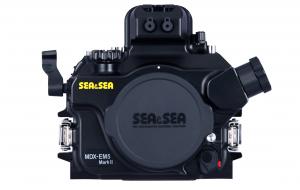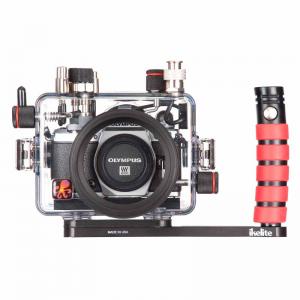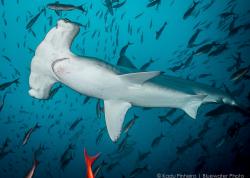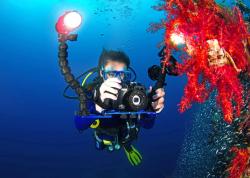Olympus OM-D E-M5 Mark II Camera Review

The newest release for Olympus' popular OM-D line of mirrorless cameras is the new OM-D E-M5 Mark II. Instead of continuing the tradition of adding a new model number to the line up, Olympus has returned to the original, ground breaking OM-D E-M5 and updated it, creating the Mark II version. While this may seem confusing it is a very common practice, and helps to keep the different classes of OM-D camera organized.
The biggest change in the new E-M5 Mark II is the improved image stabilization and increased movie recording frame rates. This puts the camera in better competition with the Sony Alpha mirrorless cameras. Sony has always included a choice of frame rate with thier cameras and finally Olympus has stepped up to the plate. In addition the shutter has been improved to work more quietly and it also features a full silent operation mode like the high quality Panasonic GH4, an excellent choice for video, to eliminate excess noise from the camera.
E-M5 Mark II Quick Specs:
16 Megapixels
Micro 4/3 Lens Mount
Flash Sync Speed: 1/250th
Max ISO: 25,600
Max Shutter Speed: 1/8000
81 Auto Focus Points
New FL-LM3 Flash included, ability to control flash intensity down to 1/64th power
Video recording at 1080 / 60p, 30p, 24p and up to 77Mbps bitrate
Improved 5-Axis, Sensor Shift Image Stabilization
Dust, Splash & Freezeproof Construction
E-M5 Mark II vs. E-M1:
The E-M5 Mark II has a variety of upgrades from the original OM-D E-M5, and even puts some competition on the OM-D E-M1 (the top of the line for the OM-D cameras). In general the body styling, deeper buffer and higher flash sync of 1/320th are the biggest benefits to choosing the E-M1.


The E-M5 Mark II has the same increased level of customization, including the very useful 1/2 switch. While you lose a couple of physical buttons from the E-M1 (ie: the dedicated viewfinder button and a dedicated AEL/AFL button) I found that all the needed controls can be programmed to one of the four Fn buttons, the record button and even the Preview button the front of the camera body.
A return to the original slim body styling keep the E-M5 Mark II body smaller, although the new FL-LM3 accessory flash is much larger, making the overall camera size taller. The control dials have been redesigned making them a very easy to turn. In addition the E-M5 Mark II adopted the larger electronic viewfinder from the E-M1.
I found when using the cameras on a recent trip to the Sea of Cortez that the E-M5 Mark II focused extremely quickly, possibly even a little better than the E-M1 with the Olympus 60mm Macro lens, a lens that is often slow to lock on focus, or prone to hunting. I had little to no focus hunting with the E-M5 Mark II, a huge improvment from the original E-M5.
In general - for underwater shooting choose the E-M1 for the higher flash sync speed, better for getting those great sunbursts, or if you like to shoot rapid fire since the E-M1 has a deeper buffer. Go with the E-M5 Mark II for improved video performance and improved image stabilization.
Recommended Lenses for E-M5 Mark II:
The Olympus OM-D E-M5 Mark II features a standard Micro 4/3 lens mount, allowing it to use lenses from all popular brands in this category. In addition to the popular Olympus and Panasonic lenses, Olympus has recently released several new lenses, which give underwater photo and video shooters more professional options for capturing wide-angle and macro shots. Below are our recommendations.

Fisheye Lenses
There are two choices for fisheye lenses, ideal for capturing reefscapes, big animals, wrecks, close-focus wide-angle and other large underwater scenes. The new Olympus 8mm Pro fisheye offers the best image quality and fast speed of f/1.8. The Panasonic 8mm fisheye lens has long been our go-to lens, delivering great photos with a full 180 degrees of coverage and widest aperture of f/3.5. Both lenses have a very close focusing distance, you can practically focus on the dome port!
Macro Lens
The best option for shooting macro with the Olympus OM-D E-M5 Mark II, is the Olympus 60mm macro lens. This lens delivers sharp 1:1 macro images and can be used with wet diopters outside your port in order to magnify your smallest subjects into great supermacro images. If that lens is too much, or you like shooting slightly larger macro, we recommend the Panasonic 45mm macro. This lens is a bit more money than the 60mm, but offers more flexibility in larger subjects, however it is not ideal for super macro.
Wide-Angle & Versatile Lenses
The E-M5 Mark II has many different wide-angle and mid-range zoom lenses to suit every underwater photographer. For wide-angle shooting, helping capture subjects like whales, sharks and sea lions, the new Olympus 7-14mm Pro lens and the classic Panasonic 7-14mm are your choices. Similar to the fisheye lenses from these brands, the Olympus will deliver slightly better image quality, but at a higher price. Wide-angle shooters will love the Olympus or Panasonic 7-14mm, choose Olympus for the best possible optic quality. The Olympus 9-18mm lens is a great choice for those on a budget who want a good wide-angle lens.
Kit lenses are an affordable way to get your camera in the water while also providing mid-range focal lengths ideal for shooting models in a pool. The Olympus 12-50mm is a great choice for ocean shooting, with a nice zoom range as well as built-in macro mode for capturing those small subjects. The Olympus 12-40mm Pro captures nice images with a f/2.8 aperture and professional level glass.
First Impressions Overall Use:
I was impressed with the general functionality of the E-M5 Mark II. The camera performed excellent underwater. It was extremely easy to set up the camera for underwater as with previous Olympus OM-D models. The variety of customizable functions is nearly limitless.
81 auto focus points allowed me to easily dial in my focus based on the composition, and even underwater without a focus light when shooting with a 60mm Macro lens focus was quick and accurate.
The LCD on the back is bright and displays movement extremely smoothly, an improvement over the LCD on previous OM-D cameras which still showed a bit of jitter when panning. In addition just like the E-M1 the improved electronic viewfinder gives 100% view and includes dioptric adjustment so you can perfect it for your eye.

Video quality is excellent, with the image stabilization working really well, even underwater. I was able to handhold the camera while shooting a nudibranch with very limited camera shake that you often encounter when trying to shoot video on a macro lens without a tripod. The one downside I have not been able to sort out is not being able to refocus in the middle of a video shot. With the E-M1 using S-AF focus, I can press the shutter half way to refocus while the camera is recording. This was not possible with the E-M5 Mark II (at least that I have been able to discover so far). You can utilize the C-AF (Continuous Auto Focus) which will refocus automatically during video recording, but I found it too slow, and sometimes it would refocus when it should not have which would mess up a shot.
Shot with the E-M5 Mark II and Nauticam Housing, lit with a single Sola 800 Photo
The one issue I had when shooting underwater was with the new accessory flash. I found on occaison it would disconnect, possibly it was slightly jarred from bouncing on the little panga, and I would be unable to use my flash, despite positive test shots prior to getting on the boat. I have never had this happen with previous OM-D cameras, and was unable to get it to work without opening the housing and jiggling the flash attachment. Out of 19 dives on the trip it failed on 2 of them.
Underwater Housings
So far both Olympus and Nauticam have produced underwater housings for the E-M5 Mark II, here are our thoughts on the use and design of these housings.
Olympus

The Olympus E-M5 Mark II housing (PT-EP13) is a pleasure to use underwater. It is very lightweight and all the buttons are wide and clearly labeled. Button and knob locations are well-placed for intuitive use of the camera in the housing by those who are familiar with controls on the camera body itself. A coldshoe mount on top of the housing lets you attach a focus light or other accessory, while mounts on bottom let you set up the housing with an Olympus or third party tray/handles (for strobe or video light attachment). The port mount supports a wide range of ports from Olympus and Zen, allowing you to use all the best lenses for underwater photo and video.
Overall, the PT-EP13 has really nice value for the money spent.
The biggest change for the Olympus OM-D E-M5 Mark II housing is that they reverted the housing style back to the PEN housings. The orginal E-M5 housing (PT-EP08) offered a new port release system which is much nicer than the PEN housings. It allowed for much easier port changes and expanded the line of ports and compatible lenses available for the E-M5 camera. We are not sure why Olympus reverted to the PEN style for the E-M5 Mark II camera, but it's definitely a disapointment for Olympus housing users, especially anyone wanting to upgrade from the E-M5 to the E-M5 Mark II.
Other than that the housing is very similar to all other Olympus housings. Contructed of polycarbonate plastic, it is rated to 60m / 130ft. It offers full camera control, however buttons are not shifted as in other housings, so single handed operation is difficult.
In summary this is an excellent option for photographers with a budget, you still get the same incredible quality from the E-M5 Mark II camera without as big an expense as the aluminum housings.
Purchase the OLYMPUS E-M5 Mk II HOUSING.
Nauticam
The Nauticam housing is machined from aluminum and depth rated to 100m / 330ft. The design is very similar to the original E-M5 design, and ships without built in handles like the E-M1.
Since the E-M5 Mark II does not have a dedicated AEL/AFL button like the E-M1 does, Nauticam did not move or redesign the housing to create a new lever for those of us who prefer to split out our Auto Focus Lock. However, just like with the original E-M5, they official movie record button has been turned into a lever, located perfectly at the back of the housing. It is very easy to reassign the movie record button to AEL/AFL and use that lever as your focus lock. I found, especially when holding onto the housing directly that this was very comfortable and a great way to shoot, especially for macro.
Shutter speed and Aperture control dials are easy to manipulate, and when well balanced for bouyancy, single handed operation is not difficult. The zoom control is the new style, larger and fully rubberized making it easy to control as well. As always the housing layout is ergonmically designed with tiered buttons placed within reach (when holding directly to the housing).
Nauticam now includes the nice silver handle brackets that incorporate with their Flexitray system and also allows for easy lanyard attachment. These brackets add stability to the handles when using strobes or larger video lights. I did appreciate the added stability, however the initial set up and subsequent tray adjustments can be time consuming. The Nauticam Flexitry utilizes multiple small screws for all its adjustable parts, so plan to set this up on a well lit, clear table.
I found when using the housing, that is was more comfortable to hold directly to the housing, versus holding onto the right handle. This is also nice for those looking to keep the housing small and streamlined, as you can attach the Nauticam handstrap to the right side to add comfort when holding the housing in this manner and not using a right handle.


On the left, holding directly onto the camera body put my fingertips right at the controls and made changing settings much easier than shooting while holding onto the handle as shown on the right.
Port changes are easy with the improved DSLR style port release lever, and with Nauticam's straightforward push on system there is very little risk of pinching or twisting an oring. The housing latch is the same as all previous mirrorless and compact latches, a large rectangle which you spin backwards to open.
Added accessories for the Nauticam add to the enjoyable user experience, such as the vacuum check system, which gives you a second security check that you o-rings are properly sealed and includes visual and audible monitoring throughout the dive with the included leak detector alarm. Flip adapters for the macro ports make adding a diopter for super macro a breeze. There is also an option to upgrade the rear LCD window to allow for the attachment of Nauticam's impressive external viewfinders.
In summary I would definitely recommend the Nauticam housing for the OM-D E-M5 Mark II, it makes using the camera underwater practically seamless compared to using it topside. With full functionality and well thought through design, in addition to the high quality aluminum construction and a full line of ports and accessories, this housing performs excellently.
Purchase the NAUTICAM E-M5 Mk II HOUSING.
SEA&SEA

The Sea & Sea housing offers a high quality, yet compact housing designed to fit the E-M5 Mark II perfectly. With a specific Mirrorless line of ports, and compatible with just about any Sea & Sea accessory this housing is a great choice for any underwater photographer.
Learn more and purchase the SEA&SEA E-M5 Mk II Housing on Bluewater Photo.
Ikelite
 Ikelite housings have always been high quality polycarbonate, and the new mirrorless line is no exception. Controls are put right at your fingertips for all important camera functions. Control symbols that are laser engraved into the back of the housing will never peel off or fade even with years of use.
Ikelite housings have always been high quality polycarbonate, and the new mirrorless line is no exception. Controls are put right at your fingertips for all important camera functions. Control symbols that are laser engraved into the back of the housing will never peel off or fade even with years of use.
Learn more and purchase the Ikelite E-M5 Mk II Housing on Bluewater Photo.
Sample Images from the Sea of Cortez:








Sample Images from Key Largo, Florida:




Reef scene shot with Olympus 9-18mm. Photo: Brent Durand
Featured Articles
RECOMMENDED ARTICLES
SUPPORT THE UNDERWATER PHOTOGRAPHY GUIDE:
The Best Service & Prices on u/w Photo Gear
 Visit Bluewater Photo & Video for all your underwater photography and video gear. Click, or call the team at (310) 633-5052 for expert advice!
Visit Bluewater Photo & Video for all your underwater photography and video gear. Click, or call the team at (310) 633-5052 for expert advice!
The Best Pricing, Service & Expert Advice to Book your Dive Trips
 Bluewater Travel is your full-service scuba travel agency. Let our expert advisers plan and book your next dive vacation. Run by divers, for divers.
Bluewater Travel is your full-service scuba travel agency. Let our expert advisers plan and book your next dive vacation. Run by divers, for divers.

































